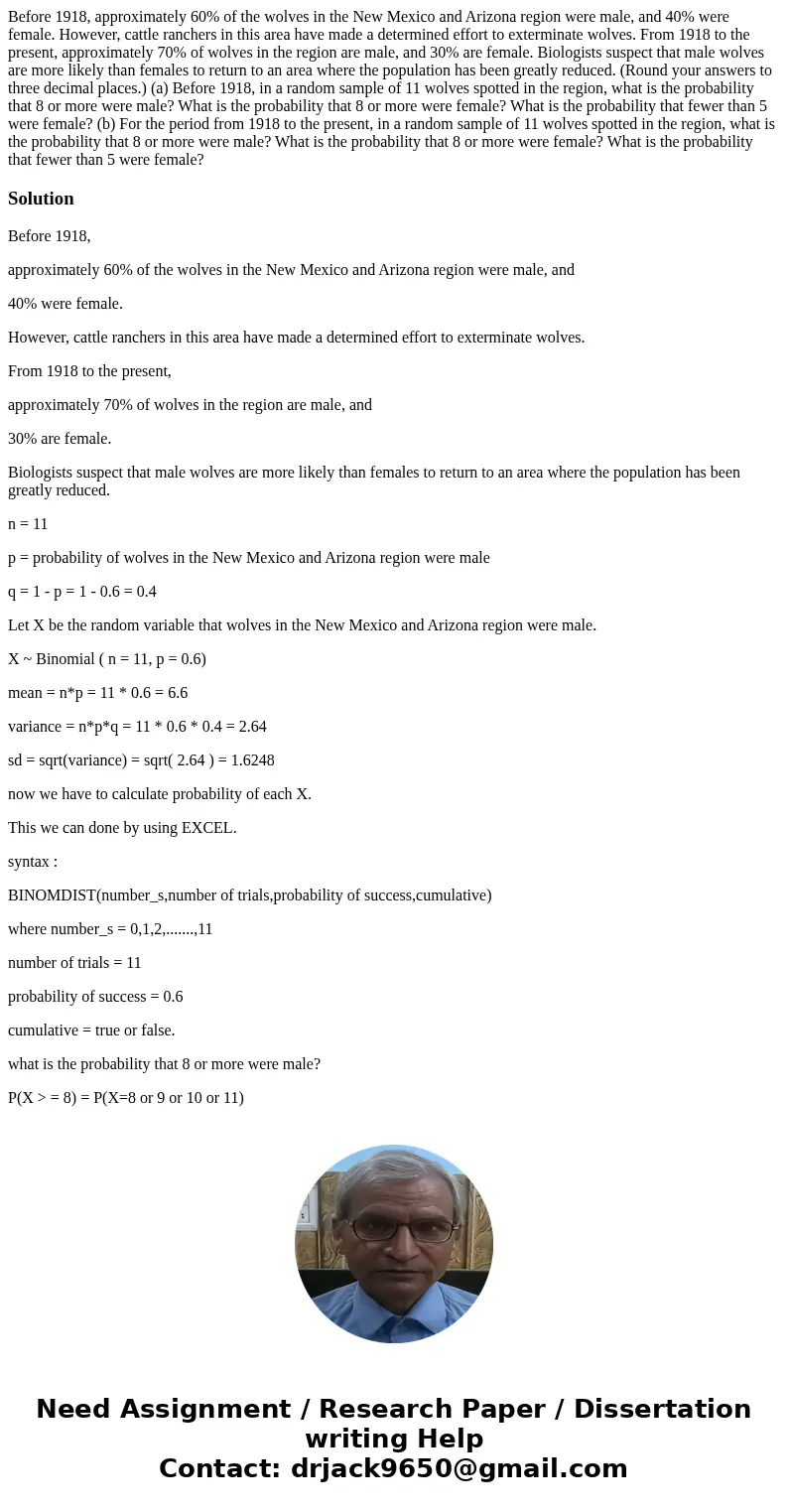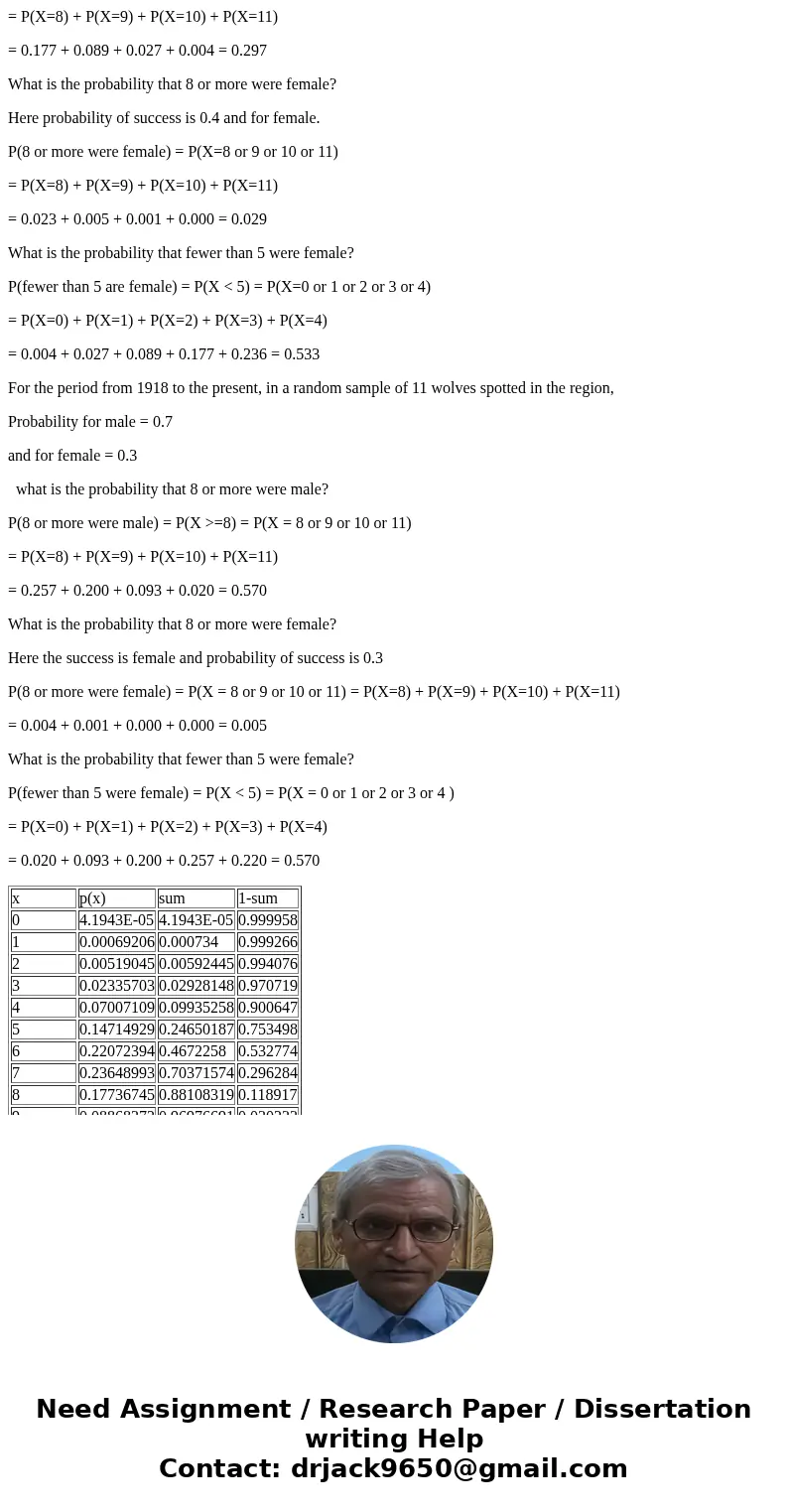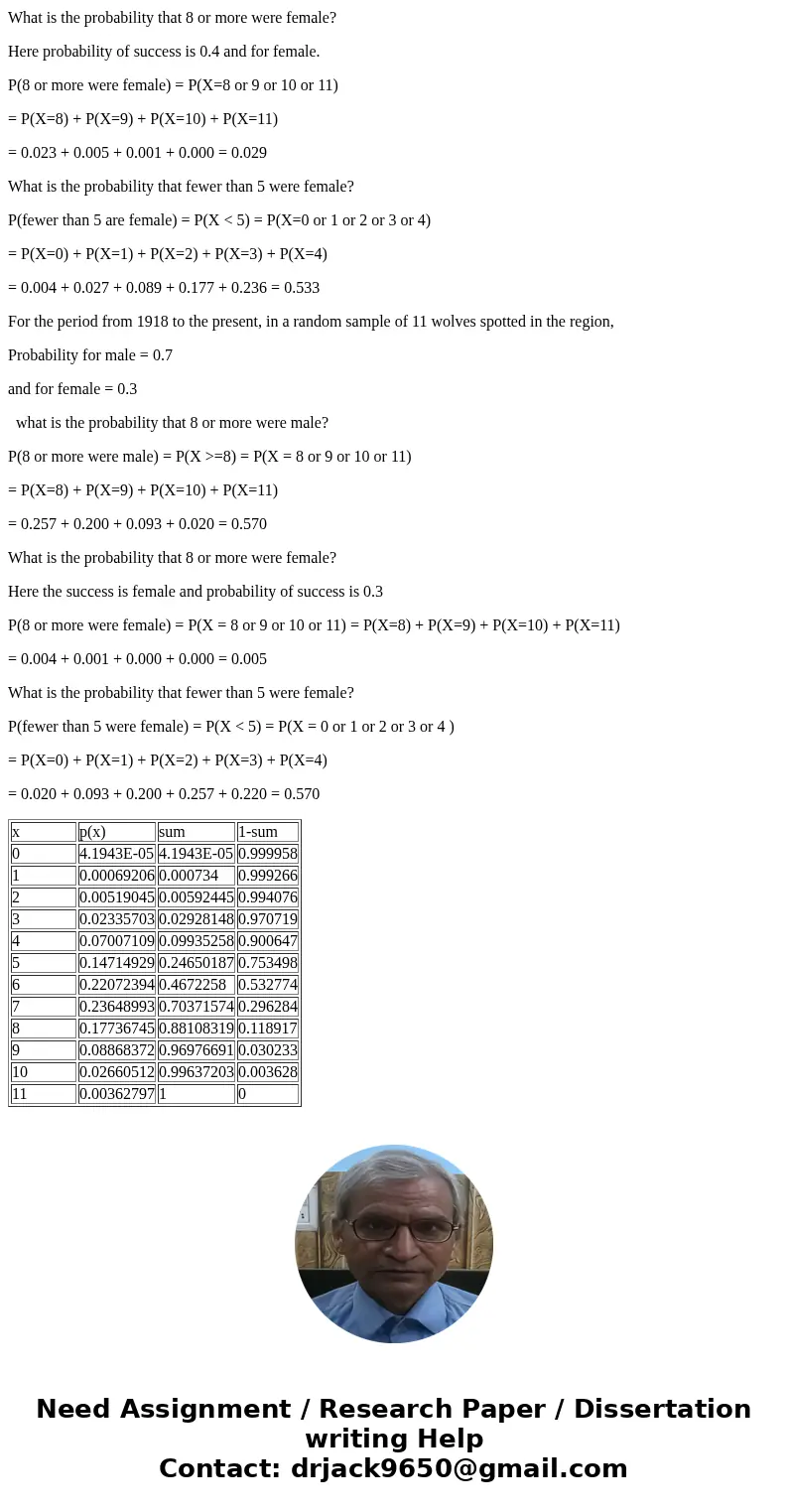Before 1918 approximately 60 of the wolves in the New Mexico
Before 1918, approximately 60% of the wolves in the New Mexico and Arizona region were male, and 40% were female. However, cattle ranchers in this area have made a determined effort to exterminate wolves. From 1918 to the present, approximately 70% of wolves in the region are male, and 30% are female. Biologists suspect that male wolves are more likely than females to return to an area where the population has been greatly reduced. (Round your answers to three decimal places.) (a) Before 1918, in a random sample of 11 wolves spotted in the region, what is the probability that 8 or more were male? What is the probability that 8 or more were female? What is the probability that fewer than 5 were female? (b) For the period from 1918 to the present, in a random sample of 11 wolves spotted in the region, what is the probability that 8 or more were male? What is the probability that 8 or more were female? What is the probability that fewer than 5 were female?
Solution
Before 1918,
approximately 60% of the wolves in the New Mexico and Arizona region were male, and
40% were female.
However, cattle ranchers in this area have made a determined effort to exterminate wolves.
From 1918 to the present,
approximately 70% of wolves in the region are male, and
30% are female.
Biologists suspect that male wolves are more likely than females to return to an area where the population has been greatly reduced.
n = 11
p = probability of wolves in the New Mexico and Arizona region were male
q = 1 - p = 1 - 0.6 = 0.4
Let X be the random variable that wolves in the New Mexico and Arizona region were male.
X ~ Binomial ( n = 11, p = 0.6)
mean = n*p = 11 * 0.6 = 6.6
variance = n*p*q = 11 * 0.6 * 0.4 = 2.64
sd = sqrt(variance) = sqrt( 2.64 ) = 1.6248
now we have to calculate probability of each X.
This we can done by using EXCEL.
syntax :
BINOMDIST(number_s,number of trials,probability of success,cumulative)
where number_s = 0,1,2,.......,11
number of trials = 11
probability of success = 0.6
cumulative = true or false.
what is the probability that 8 or more were male?
P(X > = 8) = P(X=8 or 9 or 10 or 11)
= P(X=8) + P(X=9) + P(X=10) + P(X=11)
= 0.177 + 0.089 + 0.027 + 0.004 = 0.297
What is the probability that 8 or more were female?
Here probability of success is 0.4 and for female.
P(8 or more were female) = P(X=8 or 9 or 10 or 11)
= P(X=8) + P(X=9) + P(X=10) + P(X=11)
= 0.023 + 0.005 + 0.001 + 0.000 = 0.029
What is the probability that fewer than 5 were female?
P(fewer than 5 are female) = P(X < 5) = P(X=0 or 1 or 2 or 3 or 4)
= P(X=0) + P(X=1) + P(X=2) + P(X=3) + P(X=4)
= 0.004 + 0.027 + 0.089 + 0.177 + 0.236 = 0.533
For the period from 1918 to the present, in a random sample of 11 wolves spotted in the region,
Probability for male = 0.7
and for female = 0.3
what is the probability that 8 or more were male?
P(8 or more were male) = P(X >=8) = P(X = 8 or 9 or 10 or 11)
= P(X=8) + P(X=9) + P(X=10) + P(X=11)
= 0.257 + 0.200 + 0.093 + 0.020 = 0.570
What is the probability that 8 or more were female?
Here the success is female and probability of success is 0.3
P(8 or more were female) = P(X = 8 or 9 or 10 or 11) = P(X=8) + P(X=9) + P(X=10) + P(X=11)
= 0.004 + 0.001 + 0.000 + 0.000 = 0.005
What is the probability that fewer than 5 were female?
P(fewer than 5 were female) = P(X < 5) = P(X = 0 or 1 or 2 or 3 or 4 )
= P(X=0) + P(X=1) + P(X=2) + P(X=3) + P(X=4)
= 0.020 + 0.093 + 0.200 + 0.257 + 0.220 = 0.570
| x | p(x) | sum | 1-sum |
| 0 | 4.1943E-05 | 4.1943E-05 | 0.999958 |
| 1 | 0.00069206 | 0.000734 | 0.999266 |
| 2 | 0.00519045 | 0.00592445 | 0.994076 |
| 3 | 0.02335703 | 0.02928148 | 0.970719 |
| 4 | 0.07007109 | 0.09935258 | 0.900647 |
| 5 | 0.14714929 | 0.24650187 | 0.753498 |
| 6 | 0.22072394 | 0.4672258 | 0.532774 |
| 7 | 0.23648993 | 0.70371574 | 0.296284 |
| 8 | 0.17736745 | 0.88108319 | 0.118917 |
| 9 | 0.08868372 | 0.96976691 | 0.030233 |
| 10 | 0.02660512 | 0.99637203 | 0.003628 |
| 11 | 0.00362797 | 1 | 0 |



 Homework Sourse
Homework Sourse